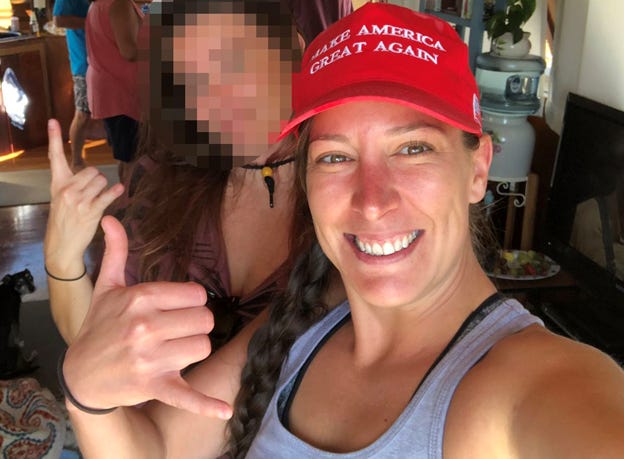Apparently, white police doing their job against belligerent, arrest resisting, threatening black males that result in their deaths cannot be left for the law to decide but a black policeman in a non-immediate danger, retreatable position with heavily armed additional police practically escorting a 105 lb, 4’5″ unarmed, non-threatening, white female climbing through a broken window, when that unthreatened policeman shoots this female at point blank range the law is thrown out the window. I’m sorry, but I cannot help but think if the policeman was white and the victim was black there would be riots going on in Washington starting Jan. 6 and continuing to this day with a giant escalation of those riots on April 14. Clearly, in Washington DC and any other democrat city if you are black you can do pretty much whatever you like, including murder, without fear of consequence. The more that message is sent the more violence and rioting and murder you are going to see.
The Ashley Babbit story is a travesty and a disgrace but the bigger disgrace is that this race war is actively being defended and promoted by mostly white liberals who also operate without fear of consequence. WHY DO YOU THINK THAT IS? Why are they promoting even instigating? Why are there no consequences?
The force was excessive so the DOJ punts on “willfulness”
| Techno FogApr 1429104 |

Today, the U.S. Attorney’s Office for the District of Columbia issued a press release explaining their decision to not prosecute the officer who shot and killed unarmed protester (and veteran) Ashli Babbitt on January 6, 2021.
It states that DOJ officials, along with the Metropolitan Police Department’s Internal Affairs Division, “conducted a thorough investigation of Ms. Babbitt’s shooting.” This included reviewing video footage, getting statements from officers and other witnesses, collecting physical evidence, and the results of Ms. Babbitt’s autopsy.
They explain:
“As members of the mob continued to strike the glass doors, Ms. Babbitt attempted to climb through one of the doors where glass was broken out. An officer inside the Speaker’s Lobby fired one round from his service pistol, striking Ms. Babbitt in the left shoulder, causing her to fall back from the doorway and onto the floor.”
You’ll notice there’s no mention of a verbal warning to Ms. Babbitt or other efforts to subdue her without the use of deadly force.
Continuing on, the DOJ maintains that the “focus of the criminal investigation was to determine whether federal prosecutors could prove that the officer violated any federal laws, concentrating on the possible application of 18 U.S.C. § 242, a federal criminal civil rights statute.”
The press release focused on the term “willfully”:

The DOJ concluded:
“The investigation revealed no evidence to establish beyond a reasonable doubt that the officer willfully committed a violation of 18 U.S.C. § 242. Specifically, the investigation revealed no evidence to establish that, at the time the officer fired a single shot at Ms. Babbitt, the officer did not reasonably believe that it was necessary to do so in self-defense or in defense of the Members of Congress and others evacuating the House Chamber.”
This conclusion should be no surprise. Not because of the law or the facts, but because of the people in charge of the Department of Justice. The U.S. Capitol Police, like the Park Police, have always had a special relationship with the DOJ – one that includes preferential treatment. This case is no different.
For starters, the three basic elements to a prosecution under 18 U.S.C. § 242 are that the defendant (1) acting under color of law; (2) willfully; (3) deprived the victim of a federally protected right.
Excessive force is easy to establish. The Supreme Court has held that the government must introduce evidence that the action of the officer in shooting to kill Babbitt was “excessive in relation” to a legitimate government objective. Kingsley v. Hendrickson, 135 S. Ct. 2466, 2473-2474 (2015). This is an objective standard – the force must be objectively unreasonable when viewed from the standpoint of a reasonable officer at the scene. Here, Babbitt was unarmed, was climbing through a window and not attacking anyone. In response, she is shot and killed. Easily excessive.
This brings us to “willfulness.”
We have serious doubts about the DOJ position that there was “no evidence” to establish beyond a reasonable doubt that the officer willfully violated Section 242. As an initial matter, the DOJ press release neglects to mention whether the officer used excessive force, instead going right to an analysis on willfulness. We believe this reveals their intent to soften the blow of the press release.
As to willfulness, 18 U.S.C. applies “when the defendant understands that he is unjustifiably invading a legally protected interest, or acts in reckless disregard of the law.” However, the defendant need not have been “thinking in constitutional terms,” as long as his “aim was not to enforce local law but to deprive a citizen of a right and that right was protected by the Constitution.” Screws v. United States, 325 U.S. 91, 106 (1945).
Here, the DOJ exaggerates – and at worst, lies – about its “willfulness burden.” We doubt the DOJ couldn’t prove willfulness in this case.
In fact, the DOJ has brought Section 242 prosecutions with less egregious facts.
As the DOJ has argued in other cases, the officer’s prior training on the use of force could be viewed “as evidence that his conduct was willful.” Are we to think that this officer didn’t have training on when force became excessive?
In another case, the DOJ argued to the Fourth Circuit Court of Appeals that to establish “willfulness,” the jury was required to find that the defendant “intended to use more force than was reasonable under the circumstances – i.e., force that violated [the victim’s] well-established due rights as a pretrial detainee.”
What makes the Babbitt case different? The victim and the location.
This case should have gone to the jury. If this killing took place in Minnesota or Chicago the results would have been different.
